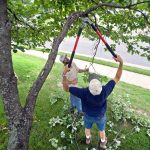4 Tree Trimming Tips You Need to Know

Spring Time Tree Trimming is Essential in Western New York
As Western New York warms up and greens up with spring, it’s prime time for homeowners to embark on an annual tree trimming habit. Tree trimming includes pruning, removing dead branches and otherwise neatening up trees and other vegetation around the yard, especially those that are near or even touching your home’s exterior.
Top 4 Reasons for Trimming Trees and Bushes
Tree trimming in the Buffalo area is essential for a number of reasons, with the top four being:
- Tree health: Improve tree health while promoting and making room for new growth.
- Aesthetics: Maintain tree and bush shape, density or size while keeping your yard looking tidy and your neighbors happy.
- Your safety: Removing dead, diseased or overgrown branches reduces the risk of them falling on you, your family or your home. Dead branches can also easily break during Western New York storms, easily damaging your home’s exterior, windows or gutters.
- Your health: Overgrown vegetation that is touching your roof or other areas of your home’s exterior provide an easy avenue for insects and other pests to skitter onto and into your home. The more overgrown your foliage is, the greater number of pests it can harbor, increasing the chances of a full-blown infestation if they do decide to come inside.
4 Must Know Tips to Tree Trimming in the Buffalo Area
Using the right tools for the job is a must, and the right tool depends upon what you’re trimming. Pruning shears are available in various sizes and strengths to take care of smaller foliage and branches. Power trimmers are another option, one that works well for fast and even trimming of hedges. Larger loppers, manual saws and chain saws can be helpful for the bigger jobs at hand.
- Thinning out trees should be done with care, removing no more than 25 percent of the crown at any one time. Branches with V-shaped, or narrow, angles tend to be weaker and easier to cut than those that jut out at wider angles.
- Keep the shape and overall appearance of the tree or bush in mind as you’re trimming. If you’re aiming to raise the crown of a tree, make sure to retain live branches for at least two-thirds of the tree’s height.
- Cut branches right above the branch collar, which is the large nub on the trunk at the base of the branch. Don’t leave long stubs sticking out, but don’t trim too closely to the branch collar, either. Doing so can increase the risk of an infestation or infection.
- Since Western New York has plenty of insects and other pests that would be glad to use branches and other vegetation to get inside your home, make sure all foliage is at least 24 inches away from your home exterior.
Making tree trimming a regular habit each spring can help keep your Buffalo area yard thriving. It can also help maintain the value of your home and ensure you receive positive results from any home inspection. Your home will be less likely to become infested by pests or damaged by falling trees and branches if you ensure those trees and branches are trimmed back each spring.


